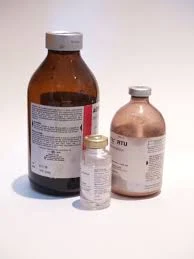Definition: The livestock antibiotic withdrawal period is the minimum time required after administering an antibiotic to an animal before its meat or milk can be safely consumed by humans. This period allows the antibiotic residue levels in the animal's tissues (muscle, liver, kidney) or milk to fall below established safety limits set by regulatory agencies.
Click the Translate button(see right) on this post to set your Own Language to understand more perfectly!!
Pressure Relief Valve Sizing Calculator
Livestock Antibiotic Withdrawal Period Calculator
Livestock Antibiotic Withdrawal Period Calculator
Continue Definition:
Livestock Antibiotic Withdrawal Period
The livestock antibiotic withdrawal period is the minimum time required after administering an antibiotic to an animal before its meat or milk can be safely consumed by humans. This period allows the antibiotic residue levels in the animal's tissues (muscle, liver, kidney) or milk to fall below established safety limits set by regulatory agencies.
Factors Affecting Withdrawal Period:
Type of Antibiotic Application:
Impact: Different antibiotics have varying elimination rates from the animal's body. Some antibiotics are metabolized and excreted quickly, while others persist for longer durations.
Examples:
Penicillin: Relatively short withdrawal period (a few days)
Tetracyclines: Moderate withdrawal period (7-14 days)
Macrolides (e.g., Erythromycin): Can have longer withdrawal periods (up to 28 days)
Dosage of Antibiotic (mg/kg or ml/kg):
Impact: Higher antibiotic doses generally require longer withdrawal periods to allow for sufficient elimination from the animal's system.
Sample Value: 2 mg/kg (milligrams per kilogram) is a typical dosage for some injectable antibiotics.
Animal Weight (kg):
Impact: Withdrawal period sometimes scales slightly with animal weight, with larger animals potentially requiring a bit longer for complete antibiotic elimination.
However, this is not the primary factor.
Withdrawal Period Example:
Let's consider a scenario:
Animal: Pig weighing 100 kg (kg)
Antibiotic: Oxytetracycline (commonly used antibiotic)
Dosage: 5 mg/kg administered intramuscularly (injected into muscle)
Finding Withdrawal Period:
Refer to Label or Veterinary Guidance: The most reliable way to determine the withdrawal period is to consult the specific antibiotic product label or seek guidance from a veterinarian. Withdrawal period information is typically included on the product label.
General Knowledge (for educational purposes only): Oxytetracycline typically has a withdrawal period of 7-21 days for meat depending on the specific formulation and route of administration. Milk withdrawal periods are usually shorter (typically a few days).
Important Points:
Never rely solely on this information for real-world scenarios. Always refer to the specific antibiotic label or consult a veterinarian for the most accurate withdrawal period for a particular situation.
Withdrawal periods are crucial for public health. Consuming animal products with antibiotic residues can lead to antibiotic resistance in humans, making it harder to treat infections.
Responsible antibiotic use: Veterinarians recommend using antibiotics only when necessary and following proper administration protocols, including adhering to withdrawal periods.
Additional Suggestions:
Record Keeping: Maintain records of all antibiotics administered to your livestock, including the type, dosage, date, and withdrawal period.
Alternative Treatments: Discuss alternative treatment options with your veterinarian whenever possible to minimize antibiotic use.
By understanding livestock antibiotic withdrawal periods and adhering to them, you can contribute to responsible antibiotic use in animal agriculture and ensure the safety of the food chain.
How it is possible to Earn Money using the knowledge of Livestock Antibiotic Withdrawal PeriodCalculation in our practical life?????
While directly calculating withdrawal periods isn't the primary way to earn money, your knowledge of livestock antibiotic withdrawal periods can be valuable in several ways within the animal agriculture industry:
Direct Applications:
Livestock Producer: Understanding withdrawal periods is crucial for any livestock producer raising animals for meat or milk production. By adhering to these periods, you can ensure your products are safe for human consumption and avoid potential economic losses due to rejected animals at slaughter or discarded milk.
Veterinarian Technician/Assistant: Veterinarians often rely on technicians and assistants to manage animal records and treatment protocols. Your knowledge can be helpful in:
Maintaining accurate records: Tracking antibiotic administration dates and withdrawal periods for each animal is essential. You can ensure proper record-keeping to avoid accidental violations.
Client communication: You can explain withdrawal periods to clients and answer their questions about antibiotic use in their animals.
Feed Store Employee: Feed stores often sell animal health products, including antibiotics. Your knowledge can be valuable in:
Responsible product sales: Educate customers about withdrawal periods and advise them on choosing appropriate antibiotics for their animals.
Preventing misuse: You can help ensure customers understand the importance of withdrawal periods and the potential consequences of misuse.
Indirect Applications:
Pharmaceutical Company Representative: Companies that develop and sell antibiotics for livestock benefit from employees who understand withdrawal periods. You could be involved in:
Product development: Knowledge of withdrawal periods can inform the development of new antibiotics with shorter or more predictable elimination times.
Client education: You can educate veterinarians and producers on the proper use and withdrawal periods for your company's antibiotic products.
Regulatory Agency: Government agencies set withdrawal period regulations to ensure food safety. Your expertise could be valuable in:
Policy development: Understanding the factors affecting withdrawal periods can help agencies develop science-based regulations.
Enforcement: You can contribute to ensuring producers adhere to withdrawal period regulations.
Animal Welfare Organizations: These organizations promote responsible antibiotic use in livestock production. You can contribute by:
Educational materials: Develop educational materials for producers about the importance of withdrawal periods and responsible antibiotic use.
Advocacy: Advocate for policies that promote responsible antibiotic use and minimize the development of antibiotic resistance.
Additional Tips:
Stay Updated: Withdrawal period regulations and best practices can evolve. Stay current on the latest information from reputable sources.
Combine Knowledge: Combine your knowledge of withdrawal periods with other areas like animal health or production management for a broader skillset.
Communication Skills: The ability to explain complex topics like withdrawal periods in a clear and concise manner is crucial for any role in animal agriculture.
By effectively utilizing your knowledge of livestock antibiotic withdrawal periods, you can contribute to responsible antibiotic use, animal health, and food safety in the animal agriculture industry. Remember, responsible antibiotic use not only protects consumers but also helps preserve the effectiveness of these vital medications for animals.
Do YOU Want To Earn Money In Various Ways, Click The Link & Explore Your Field of Interest!!!






